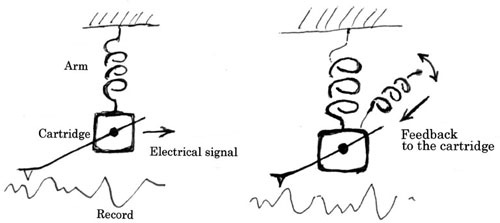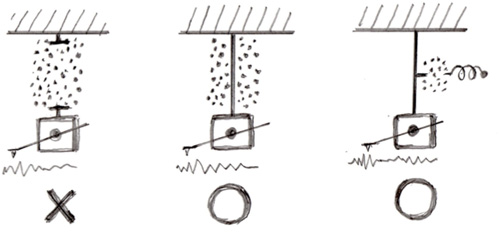|
Design Overview

The challenge for
THE GLANZ – to overcome “mechanical
vibration”
Basic components:
● By cancelling out “accumulated
blurring” and smearing we have delivered
a sound closer to “original pure sound”.
● By utilising stainless steel, which is
hard and difficult to process, we have
given THE GLANZ a sense of weight, and
also enhanced the sound quality.
● We have been able to significantly
eliminate the “subtle unwanted noises”
of the collateral mechanisms (the
auxiliary parts, and the structure that
works in harmony with them), and have
raised the static balanced arm
sensitivity to the utmost limit using
thrust bearings.
Solving the
problem of harmonic distortion caused by
the loss of mechanical vibration
A sound groove is engraved on an
analogue disc. In order to faithfully
reproduce the signal, the most important
factor is the rigidity and mass of the
tonearm, which should be integral with
the cartridge. In general, mechanical
vibration generated at the cantilever
cannot be converted at the point of
power generation, so vibration is left
in the tonearm, and sound loss occurs.
This causes the rise of the sound to
deteriorate, adds a loss of harmonic
overtone (distorted sound), and results
in a shift to the high range, which
leads to symptoms such as no low sound
and no fine sound. THE GLANZ focused on
solving these specific problems,
utilising all of the technology and
know-how that we had developed over many
years.
Using our
finely-honed skills to find a solution
to the swirls and leaps of resonance
transmission
The deep insight of a skilled craftsman
has allowed us to design THE GLANZ with
special attention to the physical
integration of the cartridge and
tonearm. THE GLANZ specifications impose
strict conditions on all aspects of
manufacture – from understanding the
centre of gravity and moment, and the
point where the resonance is
transmitted, selecting and combining
damper materials to counteract each
other, as well as the composition of the
stainless steel which is the material
used in the body of the arm, right up to
its machining accuracy and cutting
processes.
Of course it goes without saying that
each piece is individually hand finished
to the highest possible degree, as
though it were a precious work of art.
For the final hurdle, we undertake very
stringent listening tests of well known
records representing every genre of
music, and then make the final delicate
adjustments.
Creating a pure
clean sound that pierces through silence
THE GLANZ product, constructed in this
precise way, rejects all things wasteful
and extravagant, and represents the
culmination of simplicity & beauty. You
may add to this the sophisticated design
of the arm lifter. However, if you
desire, you can omit the arm lifters and
other accessories, and thereby enjoy
simple styling with sound quality as the
highest priority. You can choose from a
heavy weight Ortofon cartridge, right
through to a lightweight type cartridge.
THE GLANZ – as
perfect as a work of art
A gentle, beautifully curved line,
well-balanced size and weight, and the
finest stainless steel gloss to give you
goosebumps. In the end (and this is no
word of exaggeration) this single
tonearm has become a natural conduit for
experiencing “original pure sound”. When
you finally experience it, you will be
thrilled by the quality of sound that
can never be described as merely an
“accessory”.
With its traditional name revived to
meet the present age, ‘THE’ GLANZ takes
centre stage wearing its new crown!
Design Concept
If the fulcrum of the cartridge needle
is not securely fixed, the vibration of
the spring leads to loss, as shown in
the figure below: audio information
output is not complete, and when signal
loss is subtracted, the sound rises up
poorly, and the loss is played back as
distortion (harmonic distortion).
Signal output power generation =
amplitude of needle minus vibration of
cartridge body
Signal loss vibrates the structure
itself through the arm, and this
distorted sound returns to the
cartridge, which also results in a
further increase in the sound
distortion. It is very important to
prevent this happening in the arm.
The materials used in the manufacture of
the arm are also important; loss will
increase in materials that can warp and
bend. Furthermore, it is essential to
use a material that can handle high
frequencies. If we are to choose a
simple comparison to describe the logic
of selecting the right materials, it is
this: you won’t feel much if a hammer
has a wooden handle, but if the handle
is metal, then vibrations are
transmitted directly to the hand when
you strike something.
It is essential that the arm design
consists of a material and a structure
that can be rigidly attached to the
base. Furthermore, the base must have a
strong structure and be made from a
material that the whole body can be
firmly attached to, and supported by.
(You may recall that there was once an
echo machine that utilised steel springs
– with a spring system inside the arm
structure, the vibration corresponding
to the loss coming from the cartridge
agitates the springs and resonates, and
the distorted sound returns to the
cartridge.) If you ignore this fact, and
do not think about the structure and the
materials, unfortunately you end up with
a simple echo machine.

If we actually examine the mechanical
impedance loop of the arm, resonance
occurs in various places, and it runs
throughout the structure. Take a look at
this exaggerated comparison: a listening
room is no different to a bathroom,
where you pick up the sounds reflecting
back from the walls, and listen to music
where the sound has been slightly
muddied in the process. Furthermore,
knowing that this distorted sounds
exists, it is essential to create a
structure that dampens without losing
the rise. When the structure is
constructed with a soft material,
distorted sound is absorbed, but the
loss in sound rise is increased.
Since we normally listen to records
without being aware of the above points,
just think what an amazing experience we
can now have listening to such wonderful
audio sound. Please try the machine for
yourself and fully appreciate the true
heart of sound!
If you cannot really notice any
improvement, then please also try to
improve the rest of your equipment.
Without doubt you will find satisfaction
in the end.
 |